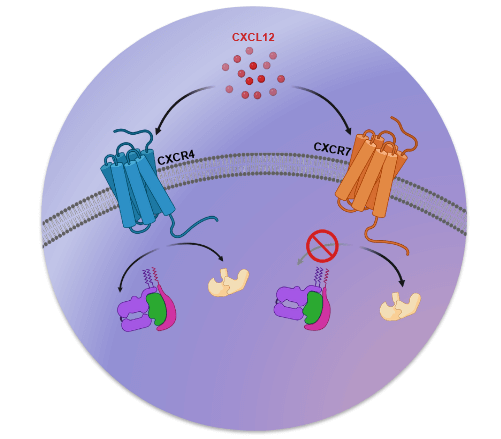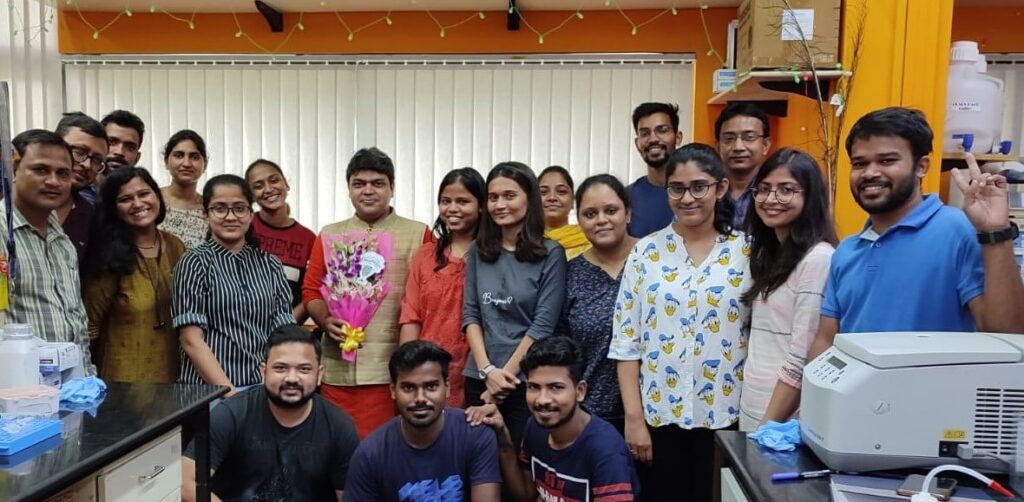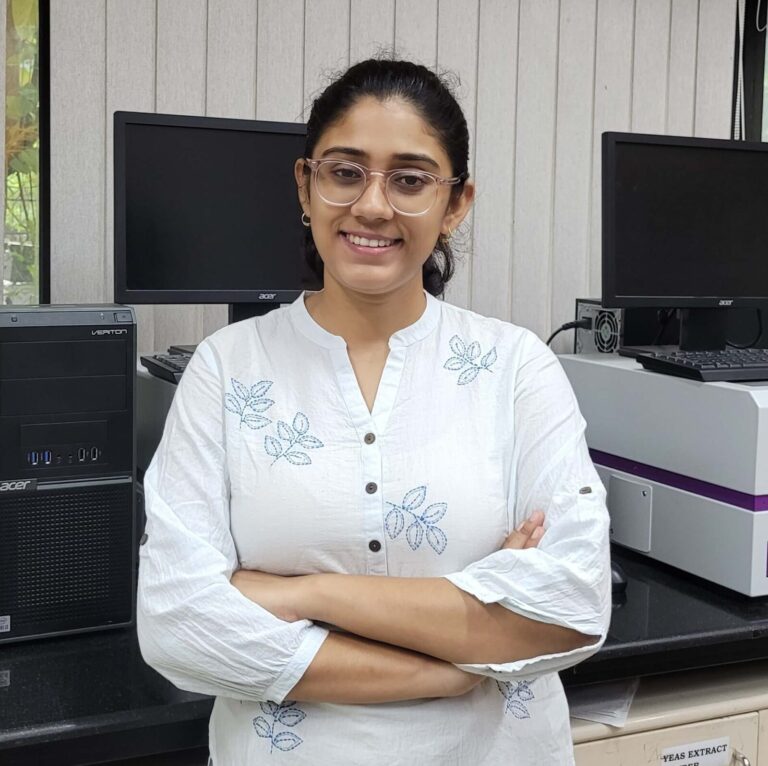Bias in the Chemokine Cascade: Unraveling CXCR4 and CXCR7's Molecular Dance
Work done in the lab of Prof. Arun K. Shukla at the Department of Biological Sciences and Bioengineering, Indian Institute of Technology, Kanpur
Parishmita Sarma is a Ph.D. student in Prof. Arun K. Shukla’s laboratory, Department of Biological Sciences and Bioengineering, Indian Institute of Technology, Kanpur. Parishmita has completed her B.Sc. in Botany (Hons) from B. Borooah College and M.Sc. in Botany specializing in genetics and molecular biology from Gauhati University, Assam. Her work primarily focused on understanding the molecular basis of biased agonism in GPCRs.
Author Interview
How would you explain your research outcomes to the non-scientific community?
Cells are the fundamental unit of life that work in an orchestrated fashion and play a crucial role in maintaining the overall functioning of an organism. The ability of cells to respond to external stimuli is a key feature. Cells possess a special class of proteins at their surface to receive external cues and convey signals to the intracellular side are known as receptors. Among cell surface receptors, GPCR is the largest family that actively regulates a diverse array of physiological processes. The GPCR family comprises more than 800 members and shares a common architecture of seven helical segments spanning the cell membrane. In response to a stimulus, GPCRs transmit signals through two main pathways: G-proteins and βarrs. Downstream G-protein signaling is well established in the field, whereas βarr is less explored. Previous studies thought βarrs sole role was to terminate G-protein signaling and wipe out receptors from the cell surface. However, later studies have unveiled the possibility of βarr to initiate its own signaling responses irrespective of G-proteins. Moreover, members of the GPCR superfamily are again classified into several classes based on their sequence homology, and these classes are further categorized into different subsets according to functional similarity.
The central focus of our study mainly lies on a special subset of the GPCR family known as Chemokine receptor. This class of 23 receptors is activated by small proteins known as chemokines. They play a pivotal role in immune response regulation, organ development, and initiation of cancer and tumor progression. Thus, they hold a special position as a target for drug development and discovery. The human genome encodes 47 chemokine members against 23 chemokine receptors, bringing up an intriguing point regarding this receptor class where one signal can activate several receptors or vice versa.In this study, we primarily focus on one fascinating pair of chemokine receptors, namely CXCR4 and CXCR7, which are activated by a common chemokine, CXCL12. Interestingly, while CXCR4 activates both G-proteins and βarr, CXCR7 solely triggers βarr signaling.
Another factor in this study is a small molecule compound named VUF11207 initially identified as a CXCR7 activating compound. This work aims to comprehend the intricate behavior of these receptors in detail. Particularly, the study delves into how CXCR4 and CXCR7 activate G-proteins and βarrs, utilizing both CXCL12 and the compound VUF11207. Notably, activation of CXCR7 does not involve G-proteins, unlike CXCR4. Additionally, VUF11207 specifically activates CXCR7, showcasing its selectivity towards this receptor. This comprehensive analysis reveals distinct downstream signaling responses between the two receptors, despite being prompted by the same signal. Moreover, the study characterizes a novel small molecule compound that exclusively activates one of the two receptors, suggesting its potential utility in therapeutic applications.

“These findings enhance our current understanding of GPCR signaling andoffer possibilities for treating pathological conditions associated with chemokine receptor dysregulation.”
How do these findings contribute to your research area?
The findings of the study have a significant impact on our research domain, as they greatly advance our comprehension of the molecular mechanisms of endogenous βarr-biased signaling shown by chemokine receptors. This represents a pivotal step toward unraveling the intricate mechanisms that underlie cellular responses. Insights into this biased receptor signaling will further open up arenas for advancement in therapeutics. Furthermore, the characterization of a CXCR7-specific agonist will help design therapeutics targeting CXCR7 signaling without inadvertently affecting CXCR4. Thus, these findings enhance our current understanding of GPCR signaling andoffer possibilities for treating pathological conditions associated with chemokine receptor dysregulation.
What was the exciting moment during your research?
Witnessing the recognition of my first research in a prestigious journal was the best feeling. Besides this, getting a chance to present work at an international conference in front of eminent scientists and research scholars in the field was a wonderful experience. Looking at their excitement to understand my work and complimenting itk at the end acted as an energy booster. As with this study, I have started my research career, every aspect of experimentation was filled with zeal, and delving into discussions about how to put together every piece of information and what insights it is giving, under the guidance of my mentor Prof. Arun K. Shukla alongside my lab senior Shubhi emerge as a constant source of delight within the laboratory confines. Overall, my first journey as a scholar was filled with so many moments to cheer on and learned a lot.
What do you hope to do next?
After completion of my Ph.D., I want to gain some more expertise in the field of cell signaling and the development of therapeutics. For that, I am planning to join a postdoctoral program. Looking toward my academic journey, I intend to delve deeper into the realm of cell signaling. A journey that will focus on unraveling the intricacies governing cellular processes in different tissues. As a researcher, I aim to contribute significantly to the realm of therapeutics, leveraging a deeper understanding of the molecular details that govern these processes.
Where do you seek scientific inspiration from?
Reading about scientists and their discoveries amazed me a lot and it made me think, it would give immense happiness when for the first time you get to reveal a hidden fact or discover something. As my academic journey proceeded, my interest in biology grew, and later, GPCRs as cell signaling modulators increased my curiosity as the same general machinery regulates more than 800 receptors.. The pivotal transformation in my journey occurred upon joining Prof Arun Shukla’s laboratory, where Arun’s profound guidance and lab members’ enthusiasm built an array of inspiration. Observing Arun’s unwavering dedication, and howy he explains every piece of data boosts my passion for science. His trust in me became a constant source of inspiration, propelling me to engage in my work enthusiastically.
How do you intend to help Indian science improve?
It fills me with immense joy to witness the rapid growth that Indian science has taken, and I wish to contribute meaningfully to this trajectory. My main goal will be to inspire and guide ignited minds nationwide, motivating them to engage in cutting-edge research actively. Suppose I would be able to excel as an independent scientist. In that case, I envision a worldwide collaboration where the combined efforts of countless inspired minds will coalesce to contribute to the global stage.
Reference: Sarma, P., Carino, C.M.C., Seetharama, D. et al. Molecular insights into intrinsic transducer-coupling bias in the CXCR4-CXCR7 system. Nat Commun 14, 4808 (2023). https://doi.org/10.1038/s41467-023-40482-9
Edited by: Sukanya Madhwal

Biopatrika: Bringing Science to Society
© Biopatrika 2023 All Rights Reserved.

